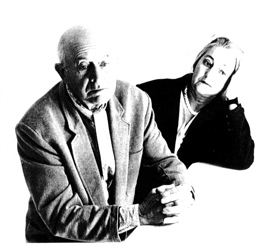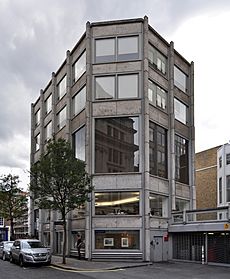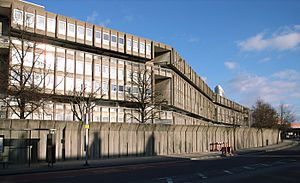Alison and Peter Smithson facts for kids
Quick facts for kids
Alison Margaret Smithson (née Gill)
Peter Denham Smithson |
|
|---|---|

Peter and Alison Smithson in 1990
|
|
| Born | June 22, 1928 September 18, 1923 Sheffield, Yorkshire, England
Stockton-on-Tees, England |
| Died | August 16, 1993 (aged 65) March 3, 2003 (aged 79) London, England
London, England |
| Nationality | British |
| Occupation | Architect |
Alison Margaret Smithson (born June 22, 1928 – died August 14, 1993) and Peter Denham Smithson (born September 18, 1923 – died March 3, 2003) were a husband-and-wife team of English architects. They worked together as a team and are well-known for their ideas in New Brutalism. This style focused on raw materials and clear structures.
Contents
Their Lives and Studies
Peter Smithson was born in Stockton-on-Tees, a town in north-east England. Alison Margaret Gill was born in Sheffield, a city in Yorkshire. Peter served in the military in India and Burma before finishing his architecture studies.
They both studied architecture at Durham University. They met there and got married in 1949. After college, they started their own architecture business in 1950. They had three children: Simon, Samantha, and Soraya. Their son, Simon, also became an architect.
Alison Smithson was also a writer. She published a novel called A Portrait of the Female Mind as a Young Girl in 1966.
What is New Brutalism?
The Smithsons are famous for being leaders of a style called New Brutalism. They saw New Brutalism as a way of thinking about architecture, not just a look. It was about making buildings that were honest and showed their true materials.
They wanted their buildings to be useful and connected to real life. This was especially important after World War II in Britain. They believed that buildings should invite people to use them in their own ways.
Their Architectural Work
The Smithsons became well-known with their design for Hunstanton School, finished in 1954. This school used simple shapes and exposed materials like brick and concrete. It showed the building's structure and pipes, instead of hiding them.
They also came up with the idea of 'streets in the sky'. This meant separating cars from people walking. This idea was popular in the 1960s for large housing projects.
Throughout their careers, they wrote a lot about their ideas and projects. This helped them become very influential among other architects.
Key Projects They Built
Here are some of the buildings they designed:
- Smithdon High School in Hunstanton, Norfolk (1949–54).
- The House of the Future exhibition (1956).
- Sugden House in Watford (1956).
- Upper Lawn Pavillion, Fonthill Estate (1959–62).
- The Economist Building in Piccadilly, London (1959–65).
- Garden building at St Hilda's College, Oxford (1968).
- Robin Hood Gardens housing complex in Poplar, East London (1969–72).
- Buildings at the University of Bath (1988).
- The Cantilever-Chair Museum in Germany (their last project).
Their Robin Hood Gardens project was a large housing complex. It aimed to create a community with 'streets in the sky'. Later, a part of this building was acquired by the Victoria and Albert Museum.
They also designed several buildings in Bath. Peter Smithson taught at the University of Bath for many years.
Designs That Were Not Built

The Smithsons also created many designs that were never built. These include:
- An entry for the Coventry Cathedral competition (1951).
- An entry for the Golden Lane Estate competition (1952).
- A design for Sheffield University.
- A design for the British Embassy in Brasília (1961).
See Also
 In Spanish: Alison y Peter Smithson para niños
In Spanish: Alison y Peter Smithson para niños




